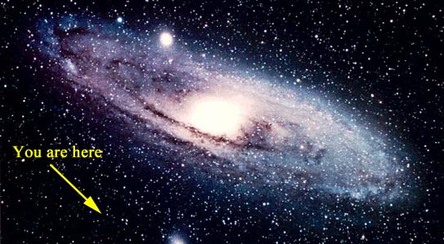Every day it's the same: At any given moment, someone, somewhere is discovering something either quiet or grand, miniscule or momentous, that changes the way we think, the way we hold space, the way we perceive the mind, the world, the galaxy and even reality itself, to the point where we will likely never be the same again.
Even better? This stunning flow of ideas and discoveries, debunkings and feral potentialities is not the slightest bit linear. It is, instead, as the mystics and gurus have known for millennia, a leaping, looping, lurching thing, jumping up and spitting divine fire before folding back on itself, only to ignite anew and singe the eyebrows of your jaded and wary soul.
Do you recognize it? It's nothing short of the cosmic dance itself, the ceaseless winking of Shiva's third eye, a trickster angel with Tourette's and a flamethrower.
Behold, the Kepler spacecraft. Its foremost (and now defunct, as it sadly broke down late last year) duty: rabid and fast-panting calculations of the stars in our tiny galaxy, in the hopes of calculating just how many might have stable, rocky planets swirling around them that might be similar to, well, Earth.
Kepler's initial conclusion, when combined with what astronomers have already discovered? Somewhere around 4,500 planets, with one in particular -- the recently discovered Kepler 78b -- having the same density and orbit speed (but alas, not the same temperature) as our own pale blue speck.
It's a stunning finding, which floored astronomers and ignited all sorts of glorious debate about What It All Might Mean. A hot little gem of a planet right here in our very own galaxy, one that meets most of the Drake equation, the formula used to calculate potential Earthiness? Plus thousands more like it somewhere out there in deep space? Fantastic. Awesome. More than enough to set curious souls newly aflame.
But of course, that was just the beginning. Along comes a hard-workin' Berkeley grad student by the name of Erik Petigura to really crunch Kepler's numbers, and write a paper exclaiming how that 4500 number is, well, probably more than a few zeros short.
That's right: the actual number of potential Earths is closer to 40 billion -- that's one in every five stars, just in our galaxy alone -- with that number possibly much higher (Kepler is reportedly very sorry it conked out too soon to tell us more).
Holy WTF, humble biped. That will do nicely, no? This is quite sufficient to rip the bodice off our naive understanding and completely ravish our sense of awe, especially when you consider that one of those 40 billion stars might actually be close enough -- just 12 light years away -- to see with the naked eye, from wherever you are, in whatever outfit you're wearing right now, in whatever scientific posture you prefer to take.
Go ahead, try it. Step outside tonight and glance skyward, pick any star and then visualize its own rocky, Earthy little ball orbiting around it, with some form of life potentially dancing a tango on top. Go ahead and multiply that awesome possibility by 40 billion, and then multiply that number exponentially, into the other billions of galaxies beyond our humble Milky Way. Feel free to pour copious amounts of wine as you do this -- it's going to be a dizzy ride.
Did it work? Did you quickly fall over in a sloppy, giggling heap as your ferociously limited mind shut off somewhere around a million and change, simply could not compute all that vast possibility, leaving you to swoon to the core at the grand, cosmic absurdity of this life, at the idea that we think we have a clue as to how it all works, and why it's all there, and what sort of grumpy, homophobic grandfather figure snapped his arthritic fingers and set it all in motion?
What a grand slap upside the head! How wonderful to be a part of this constant and ongoing explosion of our supposed reality, the eternal flux and burp of divine wisdom, consciousness refusing to hold still even for a second because it simply cannot, and never will! Who wants wine?
Do not misunderstand. It's all sorts of fun to think the odds are now overwhelming that one (or even one billion) of those planets is almost certainly home to some form of life, that some of that life is almost certainly intelligent and we might someday have sufficient technology to attempt to visit one of those planets and shake tentacles with some aliens. After all, it's the height of human hubris to believe we're the best the cosmos can do in terms of sex-obsessed monkeys with too many guns and not enough compassion.
But let's go a little wider. Further in. Right to the heart of our understanding that the minute we think we know something, the minute we have the nerve to declare a truism about life, the galaxy, love or time is the minute the goddess laughs and sheds another veil....
Read the rest of this column by clicking here
Mark Morford is the author of The Daring Spectacle: Adventures in Deviant Journalism, a mega-collection of his finest columns for the San Francisco Chronicle and SFGate, and the creator of the new Mark Morford's Apothecary iOS app. He's also a well-known ERYT yoga instructor in San Francisco. Join him on Facebook, or email him. Not to mention...
